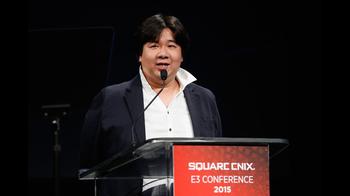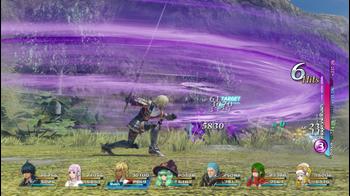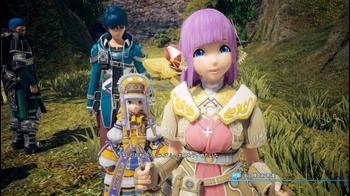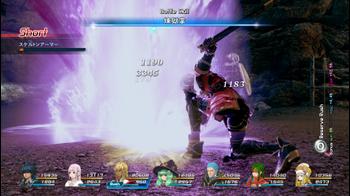Debating the world of Japanese RPGs with Star Ocean 5's Shuichi Kobayashi
For game producer Shuichi Kobayashi, Star Ocean: Integrity and Faithlessness is something of a dream project. The producer has quite a storied RPG history, having worked on Grandia III, Radiata Stories and The Last Remnant among others. But he also has a clear passion for Star Ocean - a series he's worked on before, and is now returning to for this, the fifth entry.
Kobayashi appears a jovial man, and one without the sort of finely-brushed media-readiness when I arrive to interview him. We sit down, and immediately it's not just an interview - it's a conversation. Even though we chat via (an excellent) translator, it feels natural, and it's only a matter of time before a chat between two RPG nerds turns not just to his latest game, but also to the RPG genre at large.
"I think certainly in recent years it's notable that there have been less JRPGs than there once were," Kobayashi admits. "In some ways, before starting work on Star Ocean 5 I did think that, y'know, even though technologically the games industry has made advances, that JRPGs maybe hadn't evolved so much and that maybe some of them were quite stuck in the past in terms of their technical execution as games. So, yeah - that's something I really wanted to address with Star Ocean 5. I think we have to keep innovating, keep moving, and keep improving the level of the technology.
"In Star Ocean 5 that seamlessness is a big part of that - that evolution is something I really wanted to push. I think the feeling of playing the whole game has been improved. We've maintained the classic style, but the feeling of actually playing the game has improved a lot. Certainly in the games that I make from now on I intend to keep pushing that evolution. I really hope that the rest of the JRPG genre itself will follow. I think that's something that's needed."
Here, then, we have a producer not only dedicated to furthering his own game, but also its parent genre. Kobayashi is quick to note his criticism of the JRPG genre doesn't extend to Final Fantasy, which he describes as not a JRPG but a 'global' RPG. "They've kept innovating. It's really a genre in its own right," he chuckles. Star Ocean 5, meanwhile, is a far more traditional vision of the JRPG, and Kobayashi appears proud of it.
If the goal for JRPGs is to try new things and attempt to push the envelope, it certainly feels like it embodies that intent, and sometimes to a fault: it's a game which frequently elects not to interrupt you with laborious anime cutscenes, but instead opts for in-game walk-and-talk sequences filled with expository dialogue that still maybe drag on a touch. It tries to be a little shorter to accommodate for an older audience with busier lives, but then came under fire in Japan for not being long enough. It's also dedicated to some of the traditional Japanese RPG spectacle, but trends more towards action than any other Star Ocean game before it, an interesting mix.
The solution to melding these two ideas in combat is to feature a massive seven-character party which trounces around battlefields absolutely wrecking everything in sight, something Kobayashi explains to me was a significant technical hurdle, especially on the PlayStation 3. While you have individual control of one character, the other members of your party cast spells and dash around with all the animation-prioritized flair that is JRPG tradition, and it works and is especially visually striking when things really kick up a notch.
"Certainly I've played games like The Witcher 3," Kobayashi grins when asked if the dead hand of Western RPG influence lays on his shoulder. "I've played a lot of that, and that kind of approach really helps with the immersion. The game isn't cut up into sections at any given time. A lot of my thinking there went into Star Ocean 5; our seamless philosophy there was definitely influenced from there.
"One criticism leveled against JRPGs a lot of the time is that they try to be movies, that you're stuck in a cycle of "watch a long cutscene, play the game, cutscene, game" - the game experience keeps getting stopped by the delivery of the story. That's something that I feel from a lot of the Western developers of RPGs - they're very much in that more seamless style where after you've loaded the game initially, you never feel like you've stopped playing. You're in that world without stress, without waiting for things in the middle.
"I think that combining of the JRPG system with a more open world system... it's quite important to not forget the way that we did it. I think there's a fundamental difference between what Western RPGs try to do and what Japanese RPGs typically do; they're very different approaches to games."
With all that said, Kobayashi is keen to point out that he thinks that there are elements of Japanese RPGs that are entirely unique to the genre. This is something he doesn't want to lose from Star Ocean 5 or the genre at large even as it takes cues from the rise of their Western-developed peers.
"The idea in [Western-made RPGs] is very much focused on the roleplay aspect of it all. You choose what kind of role you play within this detailed, wide-open world. You can do whatever you want. There is a main story, but it's more focused around that freedom of action. Whereas I see Japanese RPGs as something slightly different; they're a lot more story driven, and the way I approach JRPGs is that they're connected to the types of stories you find in Japanese manga and anime. Really, we're trying to create a simulated experience where you play as the hero of that kind of story. As a result, it has to be much more scenario-driven.
"It's really just a different way of using similar systems, and that's why I really wanted to try using the play-feel. The texture you get from playing a game in a more open world, but keep hold of that more scenario-driven JRPG ethos. It was very important we kept that tone."
One of the major things that helps Star Ocean: Integrity and Faithlessness retain a sense of its anime identity alongside its more dynamic and action-driven battles is its art-style. The designs come courtesy of Akira 'akiman' Yasuda, a legendary designer best known for designing eight of the most memorable and iconic video game characters in history - the original cast of Street Fighter II.
Akiman's work in Star Ocean 5 stands out as arguably the most impressive part of the game. We've reached a sort of critical mass with anime art styles where more polygons really have little to offer, and thus what you get instead are incredibly crisp, gorgeous-looking images. Star Ocean 5 was also a PS3 game in Japan, but if you cast a blind eye to sometimes-basic world geometry for a moment, you wouldn't know it to look at its impressive character models, with Akiman's designs and use of bold, bright colours really standing out wonderfully.
I think of Akiman as something of a genius, something Kobayashi laughs and nods along with when I suggest it. "Thinking about all the different designers we could've chosen in Japan, I'm certain that Akiman is clearly the best - nobody could've done it in quite the same way he did," he says.
"I think when you try to go for that photo-realistic style that a lot of games do go for these days, you naturally have to lose colour. The closer you get to reality - say you have a character wearing a suit of armor, the closer you get to a real medieval style suit of armor - the more the colours become muted. You can't really have what we have, the bold colors, in that kind of game.
"For Star Ocean 5, we really wanted to move far away from the idea of photo-realism. Instead we looked to the world of CG animation, which we think is a much better fit for this kind of scenario-driven anime and manga style storytelling. Technologically that was the place we wanted to be for the graphics too.
"One of the main reasons we used Akiman is because he's so good at creating characters. It's very easy to recognize how these characters are going to move, what fighting style they'll have, from just the visuals. We really wanted every single character to have very obvious visual hints as to what they can do. In that sense it was all part of one thinking in terms of how we structured the colour, the feel, the visual style."
One of the things Star Ocean 5 came in for some criticism for on its original Japanese release was the length of the game; as Japanese RPGs go, it's shorter than the average. Asked to guide me through the process of coming to this decision, Kobayashi is pragmatic but also absolute in explaining it as deliberate.
"The philosophy we used there was inspired by a couple of things. First of all, this is twenty years of Star Ocean, and it's also been quite a long time - about seven years - since the last one. Some of the players will have changed over the history of the series. A lot of the people who've been with the series for most of the way are now quite a bit older. Traditionally, a lot of JRPGs were very long games - a hundred hours or something.
"Nowadays with people's time... people just don't have that amount of time to devote to the game. It's quite challenging to ask players to devote hundreds of hours to a game just to reach the end. The way we've approached it is that I've decided to split the game around fifty-fifty this time between main, compulsory story quests and side activities and quests.
"I really feel that for story-driven games like this, it's important that as many people as possible play right through to the end and see the whole story, otherwise it's difficult for me to say that they played my game fully. I want to reduce the hurdles for people to get through to the end; make it easier for people to see the story.
"Of course there's still the idea that people do want to continue playing after that - a lot of people do. It's for those people we've added in lots of extra dungeons and the extra side-quests. There's also an extra difficulty mode that's unlocked after completing the main game, and that mode means you really have to work hard and make full use of all the systems in the game in order to get through it. That's a much more challenging experience with a lot of bite to it. I think there's a lot of options there, and that's really us trying to appeal to different players in different ways."
Appealing to a broad range of players is something that Kobayashi describes as "absolutely key," and touching on that topic leads into an explanation of why the game is set when it is. Sure enough, Star Ocean 5 is a little initially shorter and has an easier basic difficulty, with a 'hard mode' for purists unlocked for a second play-through. But for maximum accessibility setting it between two existing titles doesn't seem ideal. Kobayashi describes it as a necessary measure to build up to a wider future for the Star Ocean series, something he's very clearly passionate about. There are concessions for new players, however.
"With science fiction especially, if you jump straight in there's a lot of complicated terminology and scientific concepts... it can be overwhelming," he muses. "We really deliberately avoided overwhelming players by starting the story on an underdeveloped world with a low technological level. The main characters don't understand the technology as much thanks to that, and slowly throughout the story they come to understand it, but they're introduced to it gradually."
More than anything else, on this press tour for the Western release of Star Ocean 5 and after wrapping production on the game, Kobayashi seems most excited about the future. When the topic turns to Star Ocean 5's setting, he's quick to note that it's all about laying foundations for future games, and he's even more enthusiastic when asked about his thoughts on the future of the JRPG genre in general.
"The reason we chose the period we have for 5 - which is between 2 and 3 - is really nothing to do with the reception to 4. It's to do with the ongoing telling of the story. In order to tell the stories in the future after the end of 3, which is the latest in the timeline, we felt there were a number of important events and pieces of information we needed to show to players and fans so that they'll be able to follow what comes after," he explains.
"I'm very interested myself to see the Star Ocean series story play out, and to make it. Telling up to the events at the end of 3 and then really getting into how these events could be possible to happen; filling in the gaps there, continuing on - it's something I really want to see in the series."
And what of the future of the JRPG genre? Kobayashi laughs with a glee that suggests this is a question he's wanted to answer all day.
"If we're talking about technology, maybe talking about the next five years or so, maybe a little further... I'm quite interested to see the possibilities of VR at the moment. Photo-realistic worlds and experiencing a war game and so on are all okay. I'm sure someone else is doing all that now, but from my perspective I really want to see the possibilities of depicting an anime or manga style of world in a VR setting; getting the feel of being there. I'd be very interested in seeing how that goes."
He pauses tentatively, grinning, and then can't resist: "I mean, most of the heroes of most manga and anime - they're very, very popular with the ladies! Wouldn't you like to experience that?!"
This said, of course, with an infectious laugh. It would, I tell him, be preferable to VR's developers' proclivity for terrifying horror experiences.
"Yes, I very much think that's the sort of thing you could very much get from JRPGs," he laughs again. "You can be the cool hero of the world sat there with his harem all around him - I want to see that!"
Star Ocean 5 is out for PlayStation 4 on June 28th in North America and July 1st in Europe.



